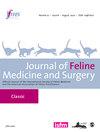Histopathological changes in testicular lesions in cats
IF 1.9
2区 农林科学
Q2 VETERINARY SCIENCES
引用次数: 0
Abstract
ObjectivesThe aim of this retrospective study was to describe the neoplastic and non-neoplastic lesions seen on histopathological examination of cat testes in Hong Kong between 2018 and 2024.MethodsA total of 26 single or dual testes samples were collected from 18 cats by veterinarians at 14 veterinary clinics and submitted for histopathological examination. Laboratory records, including signalment, lesion location, age, breed and histopathological findings, were reviewed for each cat.ResultsNeoplastic testicular lesions were seen in three older cats (median age 8.5 years; range 3–17) compared with 18 non-neoplastic lesions in 15 cats (median age 1 year; range 0.5–3). The most common non-neoplastic lesions included inflammation (in the testes, epididymis, tunics and ductus deferens), cryptorchidism, and one case each of polyorchidism and epididymal cyst formation. Two of the testes with inflammation were identified on immunohistochemical staining as feline coronavirus-infected and one pair of testes was associated with the presence of extracellular Gram-negative bacteria at the lesion site. Three different neoplastic lesions were identified, one each of Sertoli cell tumour, leiomyoma and fibrosarcoma.Conclusions and relevanceNon-neoplastic testicular lesions were most common, including inflammation, cryptorchidism, polyorchidism and epididymal cysts. To our knowledge, leiomyoma and fibrosarcoma have not been reported in cat testes before and represent important differential diagnoses for testicular lesions.猫睾丸病变的组织病理学变化
目的这项回顾性研究旨在描述2018年至2024年间香港猫睾丸组织病理学检查中出现的肿瘤性和非肿瘤性病变。方法兽医在14家兽医诊所从18只猫身上共采集了26个单睾丸或双睾丸样本,并提交进行组织病理学检查。结果3只年龄较大的猫(中位年龄为8.5岁;年龄范围为3-17岁)出现了睾丸肿瘤性病变,而15只猫(中位年龄为1岁;年龄范围为0.5-3岁)出现了18个非肿瘤性病变。最常见的非肿瘤性病变包括炎症(睾丸、附睾、外膜和输精管)、隐睾症以及多睾症和附睾囊肿形成各一例。经免疫组化染色鉴定,其中两个有炎症的睾丸感染了猫冠状病毒,一对睾丸的病变部位存在细胞外革兰氏阴性菌。结论和相关性非肿瘤性睾丸病变最常见,包括炎症、隐睾症、多睾症和附睾囊肿。据我们所知,猫睾丸中从未发现过子宫肌瘤和纤维肉瘤,它们是睾丸病变的重要鉴别诊断依据。
本文章由计算机程序翻译,如有差异,请以英文原文为准。
求助全文
约1分钟内获得全文
求助全文
来源期刊
CiteScore
3.90
自引率
17.60%
发文量
254
审稿时长
8-16 weeks
期刊介绍:
JFMS is an international, peer-reviewed journal aimed at both practitioners and researchers with an interest in the clinical veterinary healthcare of domestic cats. The journal is published monthly in two formats: ‘Classic’ editions containing high-quality original papers on all aspects of feline medicine and surgery, including basic research relevant to clinical practice; and dedicated ‘Clinical Practice’ editions primarily containing opinionated review articles providing state-of-the-art information for feline clinicians, along with other relevant articles such as consensus guidelines.

 求助内容:
求助内容: 应助结果提醒方式:
应助结果提醒方式:


